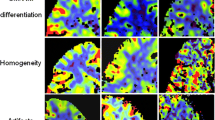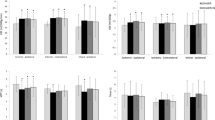Abstract
The purpose of this study was to evaluate the impact of various iodine contrast concentrations on image quality in computed tomography (CT) perfusion studies. Twenty-one patients with suspicion of cerebral ischemia underwent perfusion CT using two different iodine contrast concentrations: 11 patients received iomeprol 300 (iodine concentration: 300 mg/ml ) while ten received the same volume of iomeprol 400 (iodine concentration: 400 mg/ml). Scan parameters were kept constant for both groups. Maps of cerebral blood flow (CBF), cerebral blood volume (CBV), and time to peak (TTP) were calculated from two adjacent slices. Quantitative comparisons were based on measurements of the maximum enhancement [Hounsfield units (HU)] and signal-to-noise index (SNI) on CBF, CBV, and TTP images. Determinations of grey-to-white-matter delineation for each iodine concentration were performed by two blinded readers. Only data from the non-ischemic hemispheres were considered. Both maximum enhancement and SNI values were higher after iomeprol 400, resulting in significantly better image quality in areas of low perfusion. No noteworthy differences were found for normal values of CBF, CBV, and TTP. Qualitative assessment of grey/white matter contrast on CBF and CBV maps revealed better performance for iomeprol 400. For brain perfusion studies, highly concentrated contrast media such as iomeprol 400 is superior to iomeprol 300.




Similar content being viewed by others
References
Latchaw RE, Yonas H, Hunter GJ, Yuh WTC, Ueda T, Sorensen AG, Sunshine JL, Biller J, Wechsler L, Higashida R, Hademenos G (2003) Guidelines and recommendations for perfusion imaging in cerebral ischemia. A scientific statement for healthcare professionals by the writing group on perfusion imaging, from the Council on Cardiovascular Radiology of the American Heart Association. Stroke 34:1084–1104
Koenig M, Kraus M, Theek C, Klotz E, Gehlen W, Heuser L (2001) Quantitative assessment of the ischemic brain by means of perfusion related parameters derived from perfusion CT. Stroke 32:431–437
Wintermark M, Reichhart M, Thiran JP, Maeder P, Chalaron M, Schnyder P, Bogousslavsky J, Meuli R (2002) Prognostic accuracy of cerebral blood flow measurements by perfusion computed tomography, at the time of emergency room admission, in acute stroke patients. Ann Neurol 51:417–432
Klotz E, König M (1999) Perfusion measurements of the brain: using dynamic CT for the quantitative assessment of cerebral ischemia in acute stroke. Eur J Radiol 30:170–184
Axel L (1980) Cerebral blood flow determination by rapid-sequence computed tomography: theoretical analysis. Radiology 137:679–686
Wintermark M, Maeder P, Verdun FR, Thiran JP, Valley JF, Schnyder P, Meuli R (2000) Using 80 kVp versus 120 kVp in perfusion CT measurement of regional cerebral blood flow. Am J Neuroradiol 21:1881–1884
Mayer TE, Hamann GF, Baranczyk J, Rosengarten B, Klotz E, Wiesmann, M, Missler U, Schulte-Altedorneburg G, Brueckmann HJ (2000) Dynamic CT perfusion imaging of acute stroke. Am J Neuroradiol 21:1441–1449
Koenig M, Klotz E, Luka B, Venderink DJ, Spittler JF, Heuser L (1998) Perfusion CT of the brain: diagnostic approach for early detection of ischemic stroke. Radiology 209:85–93
Eastwood JD, Lev MH, Azhari T, Lee TY, Barboriak DP, Delong DM, Fitzek C, Herzau M, Wintermark M, Meuli R, Brazier D, Provenzale JM (2002) CT perfusion scanning with deconvolution analysis: pilot study in patients with acute middle cerebral artery stroke. Radiology 222:227–236
Esteban JM, Cervera V (2004) Perfusion CT and angio CT in the assessment of acute stroke. Neuroradiology 46:705–715
Prokop M (2003) Multislice CT: technical principles and future trends. Eur Radiol 13(Suppl 5):3–13
Heiken JP, Brink JA, McClennan BL, Sagel SS, Crowe TM, Gaines MV (1995) Dynamic incremental CT: effect of volume and concentration of contrast material and patient weight on hepatic enhancement. Radiology 1995:353–357
Brink J (2003) Use of high-concentration contrast media: principles and rationale – body computed tomography. In: Bonomo L, Foley DW, Imhof H, Rubin G (eds) Multidetector computed tomography technology: Advances in imaging techniques. Royal Society of Medicine Press, London, pp 197–231
Wintermark M, Smith WS, Ko NU, Quist M, Schnyder P, Dillon WP (2004) Dynamic perfusion CT: optimizing the temporal resolution and contrast volume for calculation of perfusion CT parameters in stroke patients. Am J Neuroradiol 25:720–729
Gillard JH, Antoun NM, Burnet NG, Pickard JD (2001) Reproducibility of quantitative CT perfusion imaging. Br J Radiol 74:552–555
Dawson P (1997) Contrast agents as tracers. In: Miles K, Dawson P, Blomley M (eds): Functional computed tomography. ISIS Medical Media, Oxford pp 29–45
Koenig M, Bueltmann E, Hering von Diepenbroick V, Koenen D, Heuser L (2001) Increase of contrast signal by means of low-tube voltage in CT perfusion imaging of the brain. Radiology 221(Suppl):346
Lev MH, Nichols SJ (2000) Computed tomographic angiography and computed tomographic perfusion imaging of hyperacute stroke. Top Magn Reson Imaging 11:273–287
Wintermark M, Reichhart M, Cuisenaire O, Maeder P, Thiran JP, Schnyder P, Bogousslavsky J, Meuli R (2002) Comparison of admission perfusion computed tomography and qualitative diffusion- and perfusion-weighted magnetic resonance imaging in acute stroke patients. Stroke 33:2025–2031
König M (2003) Brain perfusion CT in acute stroke: current status. Eur J Radiol 45:11–22
Tomandl BF, Klotz E, Handschuh R, Stemper B, Reinhardt F, Huk WJ, Eberhardt KE, Fateh-Moghadam S (2003) Comprehensive imaging of ischemic stroke with multisection CT. RadioGraphics 23:565–592
Blomley MJ, Dawson P (1997) Bolus dynamics: theoretical and experimental aspects. Br J Radiol 70:351–359
Leenders KL, Perani D, Lammertsma AA, Heather JD, Buckingham P, Healy MJ, Gibbs JM, Wise RJ, Hatazawa J, Herold S, Beany RP, Brooks DJ, Spinks T, Rhodes C, Frackowiak RSJ, Jones T (1990) Cerebral blood flow, blood volume and oxygen utilization. Normal values and effect of age. Brain 113:27–47
Gillard JH, Minhas PS, Hayball MP, Bearcroft PW, Antoun NM, Freer CE, Mathews JC, Miles KA, Pickard JD (2000) Assessment of quantitative computed tomographic cerebral perfusion imaging with H2(15)O positron emission tomography. Neurol Res 22:457–464
Author information
Authors and Affiliations
Corresponding author
Rights and permissions
About this article
Cite this article
König, M., Bültmann, E., Bode-Schnurbus, L. et al. Image quality in CT perfusion imaging of the brain. Eur Radiol 17, 39–47 (2007). https://doi.org/10.1007/s00330-006-0277-3
Received:
Revised:
Accepted:
Published:
Issue Date:
DOI: https://doi.org/10.1007/s00330-006-0277-3




